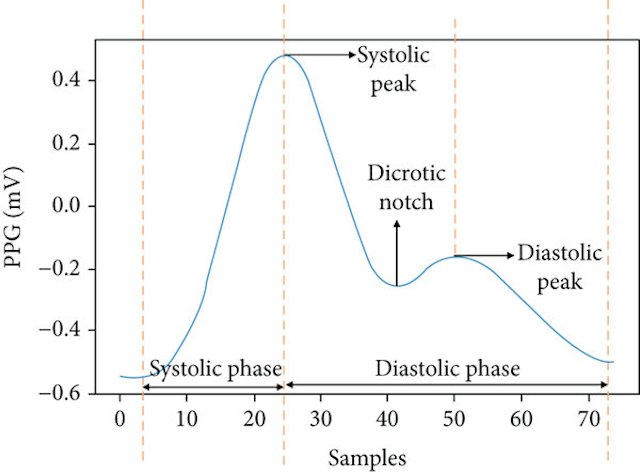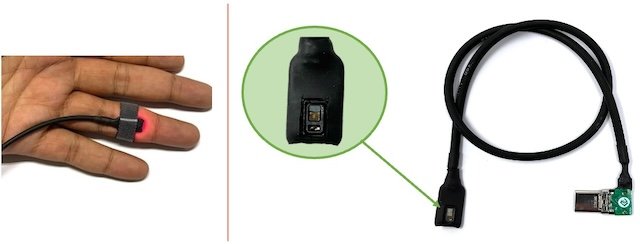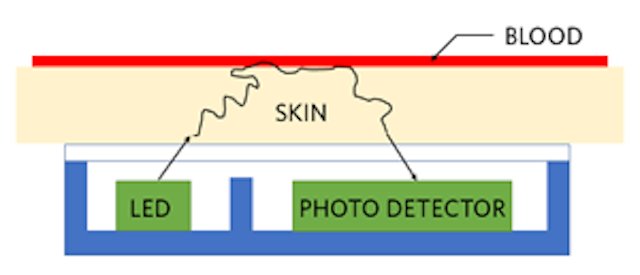Project update 3 of 16
Photoplethysmography on the HealthyPi Move
by Ashwin WhitchurchHello to all our supporters. In case you missed our launch announcement, we are excited to announce that the HealthyPi Move crowdfunding campaign is now live! (Here is the full launch annoucement.)
In this post, we wanted to talk about Photoplethysmography (PPG) and the differences between the PPG waveform from the finger versus from the wrist and why we chose the finger for HealthyPi Move. We will also discuss the significance of the PPG waveform. HealthyPi Move uses the PPG signal to measure heart rate, blood oxygen saturation (SpO2), and blood pressure. Below you can see a real recording of the PPG waveform from HealthyPi Move.
The PPG sensor on HealthyPi Move is located on the finger, as shown in the image below. This is connected to the main board via a flexible USB cable. Although, for now, the sensor is held on the finger using a strip of black velcro, we are working on a more comfortable and flexible finger ring to hold the sensor. We have also recently added a wrist sensor to HealthyPi Move, which can be used to measure PPG from the wrist and allowing cable-free operation as well.
What is Photoplethysmography (PPG)?
Photoplethysmography (PPG) is conceptually simple - it measures the change in light absorption of blood as it flows through the blood vessels. The PPG waveform you see on pulse oximeters or HealthyPi Move is a plot of light absorption over time, where a single PPG wave represents one cardiac cycle (or one heartbeat). Reflectance-based sensors use a light source and a photodetector to measure the light absorption of blood. The light source emits light into the skin and the photodetector measures the amount of light that is reflected back. The amount of light that is reflected back depends on the amount of blood in the blood vessels.
PPG Readings From the Finger or the Wrist
We initially chose the finger for the PPG sensor on HealthyPi Move. This is because of the clearly higher signal quality and amplitude of the PPG waveform from the finger, but later decided to have both sensors, one the wrist and one on the finger using a cable connected to the USB Type-C port of HealthyPi Move. Let’s take a closer look at PPG from the finger versus the wrist.
PPG can be taken from different parts of the body, but the most common locations are the finger and the wrist. The PPG waveform from the finger is more pronounced and has a higher amplitude compared to the PPG waveform from the wrist. This is because the blood vessels in the finger are closer to the surface of the skin and the blood flow is more turbulent. The PPG waveform from the wrist is less pronounced and has a lower amplitude because the blood vessels are deeper and the blood flow is less turbulent. However, the PPG waveform from the wrist is still useful for measuring heart rate and oxygen saturation, and given the convenience factor of have a wrist sensor, it has it’s own advantages, which in some cases outweigh the signal-quality differences.
The raw PPG signal consists of both an alternating current (AC) component and a direct (DC) component. The AC component is the pulsatile component of the PPG signal and is due to the change in blood volume in the blood vessels as the heart beats. It is valuable for cardiac output measurements. The DC component, on the other hand, is due to light absorption by the skin, muscle, and bone and is not useful for measuring the heart rate or oxygen saturation.

The DC component is usually removed by high-pass filtering of the PPG signal, leaving only the AC component. The AC/DC ratio is called the perfusion index (PI) and is a measure of the strength of the PPG signal. A high PI indicates a strong PPG signal. The resultant AC waveform is then used to calculate the heart rate, blood oxygen saturation (SpO2), and blood pressure on HealthyPi Move. This difference in the signal quality of the PPG waveform from the finger versus the wrist is important when designing wearable devices that use PPG to measure heart rate and oxygen saturation. This paper by Pei-Yun Tsai, et. al., for example, compares the morphology changes in the PPG waveform from the finger and the wrist and suggests ways to improve the signal quality of the PPG waveform from the wrist, but the PPG waveform from the finger is still superior. For research and clinical studies, quality of the PPG waveform is very important so we hope to provide a high quality PPG waveform with HealthyPi Move. After DC removal, the ideal PPG waveform of a finger signal looks like this:

In the above image, the systolic peak indicates the rapid change in bloodflow during systole (when the heart contracts) while the diastolic peak indicates the slower change in bloodflow during diastole (when the heart relaxes and blood flows back). The little bump in the middle is the dicrotic notch, which is believed to be due to the closure of the aortic valve, though opinions differ on this. As you can see, the PPG waveform tells us much more about cardiac output than just the heart rate. If you would like to learn more about other characteristics, check out this Chapter on Deranged Physiology, which explains a LOT more about the different features of the arterial line waveform.
We hope this post has given you a better understanding of the PPG waveform and why we chose the finger for HealthyPi Move. In a future post, we will talk about the clinical significance of the PPG waveform and how it can be used to measure heart rate, oxygen saturation, and blood pressure. Stay tuned!










